David Harwath
Probing the Robustness Properties of Neural Speech Codecs
May 30, 2025Abstract:Neural speech codecs have revolutionized speech coding, achieving higher compression while preserving audio fidelity. Beyond compression, they have emerged as tokenization strategies, enabling language modeling on speech and driving paradigm shifts across various speech processing tasks. Despite these advancements, their robustness in noisy environments remains underexplored, raising concerns about their generalization to real-world scenarios. In this work, we systematically evaluate neural speech codecs under various noise conditions, revealing non-trivial differences in their robustness. We further examine their linearity properties, uncovering non-linear distortions which partly explain observed variations in robustness. Lastly, we analyze their frequency response to identify factors affecting audio fidelity. Our findings provide critical insights into codec behavior and future codec design, as well as emphasizing the importance of noise robustness for their real-world integration.
VoiceStar: Robust Zero-Shot Autoregressive TTS with Duration Control and Extrapolation
May 26, 2025Abstract:We present VoiceStar, the first zero-shot TTS model that achieves both output duration control and extrapolation. VoiceStar is an autoregressive encoder-decoder neural codec language model, that leverages a novel Progress-Monitoring Rotary Position Embedding (PM-RoPE) and is trained with Continuation-Prompt Mixed (CPM) training. PM-RoPE enables the model to better align text and speech tokens, indicates the target duration for the generated speech, and also allows the model to generate speech waveforms much longer in duration than those seen during. CPM training also helps to mitigate the training/inference mismatch, and significantly improves the quality of the generated speech in terms of speaker similarity and intelligibility. VoiceStar outperforms or is on par with current state-of-the-art models on short-form benchmarks such as Librispeech and Seed-TTS, and significantly outperforms these models on long-form/extrapolation benchmarks (20-50s) in terms of intelligibility and naturalness. Code and model weights: https://github.com/jasonppy/VoiceStar
Rhapsody: A Dataset for Highlight Detection in Podcasts
May 26, 2025Abstract:Podcasts have become daily companions for half a billion users. Given the enormous amount of podcast content available, highlights provide a valuable signal that helps viewers get the gist of an episode and decide if they want to invest in listening to it in its entirety. However, identifying highlights automatically is challenging due to the unstructured and long-form nature of the content. We introduce Rhapsody, a dataset of 13K podcast episodes paired with segment-level highlight scores derived from YouTube's 'most replayed' feature. We frame the podcast highlight detection as a segment-level binary classification task. We explore various baseline approaches, including zero-shot prompting of language models and lightweight finetuned language models using segment-level classification heads. Our experimental results indicate that even state-of-the-art language models like GPT-4o and Gemini struggle with this task, while models finetuned with in-domain data significantly outperform their zero-shot performance. The finetuned model benefits from leveraging both speech signal features and transcripts. These findings highlight the challenges for fine-grained information access in long-form spoken media.
VoiceCraft-Dub: Automated Video Dubbing with Neural Codec Language Models
Apr 03, 2025Abstract:We present VoiceCraft-Dub, a novel approach for automated video dubbing that synthesizes high-quality speech from text and facial cues. This task has broad applications in filmmaking, multimedia creation, and assisting voice-impaired individuals. Building on the success of Neural Codec Language Models (NCLMs) for speech synthesis, our method extends their capabilities by incorporating video features, ensuring that synthesized speech is time-synchronized and expressively aligned with facial movements while preserving natural prosody. To inject visual cues, we design adapters to align facial features with the NCLM token space and introduce audio-visual fusion layers to merge audio-visual information within the NCLM framework. Additionally, we curate CelebV-Dub, a new dataset of expressive, real-world videos specifically designed for automated video dubbing. Extensive experiments show that our model achieves high-quality, intelligible, and natural speech synthesis with accurate lip synchronization, outperforming existing methods in human perception and performing favorably in objective evaluations. We also adapt VoiceCraft-Dub for the video-to-speech task, demonstrating its versatility for various applications.
Scaling Rich Style-Prompted Text-to-Speech Datasets
Mar 06, 2025Abstract:We introduce Paralinguistic Speech Captions (ParaSpeechCaps), a large-scale dataset that annotates speech utterances with rich style captions. While rich abstract tags (e.g. guttural, nasal, pained) have been explored in small-scale human-annotated datasets, existing large-scale datasets only cover basic tags (e.g. low-pitched, slow, loud). We combine off-the-shelf text and speech embedders, classifiers and an audio language model to automatically scale rich tag annotations for the first time. ParaSpeechCaps covers a total of 59 style tags, including both speaker-level intrinsic tags and utterance-level situational tags. It consists of 342 hours of human-labelled data (PSC-Base) and 2427 hours of automatically annotated data (PSC-Scaled). We finetune Parler-TTS, an open-source style-prompted TTS model, on ParaSpeechCaps, and achieve improved style consistency (+7.9% Consistency MOS) and speech quality (+15.5% Naturalness MOS) over the best performing baseline that combines existing rich style tag datasets. We ablate several of our dataset design choices to lay the foundation for future work in this space. Our dataset, models and code are released at https://github.com/ajd12342/paraspeechcaps .
How to Learn a New Language? An Efficient Solution for Self-Supervised Learning Models Unseen Languages Adaption in Low-Resource Scenario
Nov 27, 2024



Abstract:The utilization of speech Self-Supervised Learning (SSL) models achieves impressive performance on Automatic Speech Recognition (ASR). However, in low-resource language ASR, they encounter the domain mismatch problem between pre-trained and low-resource languages. Typical solutions like fine-tuning the SSL model suffer from high computation costs while using frozen SSL models as feature extractors comes with poor performance. To handle these issues, we extend a conventional efficient fine-tuning scheme based on the adapter. We add an extra intermediate adaptation to warm up the adapter and downstream model initialization. Remarkably, we update only 1-5% of the total model parameters to achieve the adaptation. Experimental results on the ML-SUPERB dataset show that our solution outperforms conventional efficient fine-tuning. It achieves up to a 28% relative improvement in the Character/Phoneme error rate when adapting to unseen languages.
Dynamic-SUPERB Phase-2: A Collaboratively Expanding Benchmark for Measuring the Capabilities of Spoken Language Models with 180 Tasks
Nov 08, 2024



Abstract:Multimodal foundation models, such as Gemini and ChatGPT, have revolutionized human-machine interactions by seamlessly integrating various forms of data. Developing a universal spoken language model that comprehends a wide range of natural language instructions is critical for bridging communication gaps and facilitating more intuitive interactions. However, the absence of a comprehensive evaluation benchmark poses a significant challenge. We present Dynamic-SUPERB Phase-2, an open and evolving benchmark for the comprehensive evaluation of instruction-based universal speech models. Building upon the first generation, this second version incorporates 125 new tasks contributed collaboratively by the global research community, expanding the benchmark to a total of 180 tasks, making it the largest benchmark for speech and audio evaluation. While the first generation of Dynamic-SUPERB was limited to classification tasks, Dynamic-SUPERB Phase-2 broadens its evaluation capabilities by introducing a wide array of novel and diverse tasks, including regression and sequence generation, across speech, music, and environmental audio. Evaluation results indicate that none of the models performed well universally. SALMONN-13B excelled in English ASR, while WavLLM demonstrated high accuracy in emotion recognition, but current models still require further innovations to handle a broader range of tasks. We will soon open-source all task data and the evaluation pipeline.
SyllableLM: Learning Coarse Semantic Units for Speech Language Models
Oct 05, 2024Abstract:Language models require tokenized inputs. However, tokenization strategies for continuous data like audio and vision are often based on simple heuristics such as fixed sized convolutions or discrete clustering, which do not necessarily align with the semantic structure of the data. For speech in particular, the high resolution of waveforms (16,000 samples/second or more) presents a significant challenge as speech-based language models have had to use several times more tokens per word than text-based language models. In this work, we introduce a controllable self-supervised technique to merge speech representations into coarser syllable-like units while still preserving semantic information. We do this by 1) extracting noisy boundaries through analyzing correlations in pretrained encoder losses and 2) iteratively improving model representations with a novel distillation technique. Our method produces controllable-rate semantic units at as low as 5Hz and 60bps and achieves SotA in syllabic segmentation and clustering. Using these coarse tokens, we successfully train SyllableLM, a Speech Language Model (SpeechLM) that matches or outperforms current SotA SpeechLMs on a range of spoken language modeling tasks. SyllableLM also achieves significant improvements in efficiency with a 30x reduction in training compute and a 4x wall-clock inference speedup.
Self-supervised Speech Models for Word-Level Stuttered Speech Detection
Sep 16, 2024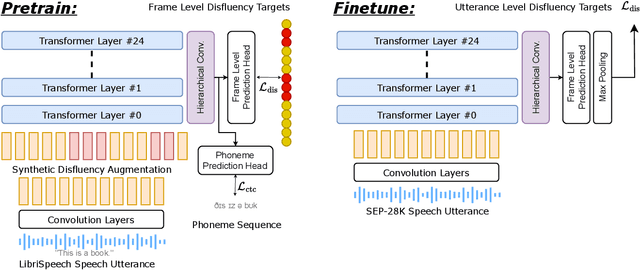
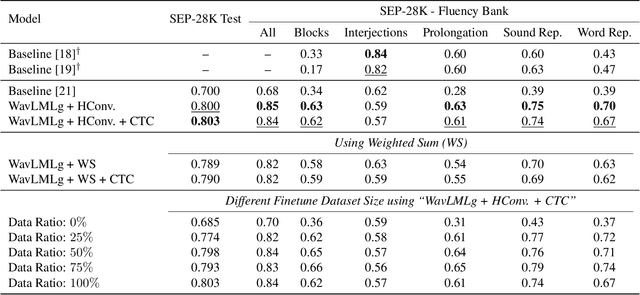

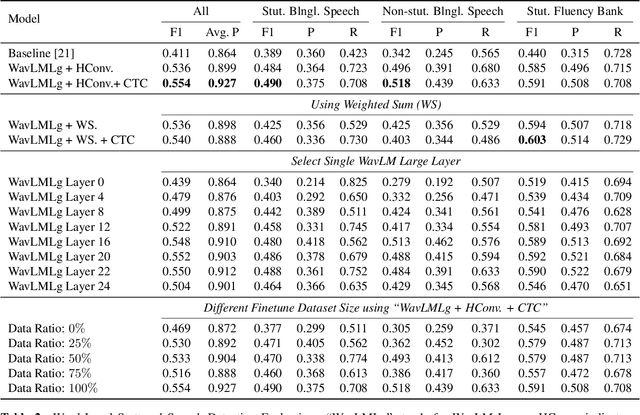
Abstract:Clinical diagnosis of stuttering requires an assessment by a licensed speech-language pathologist. However, this process is time-consuming and requires clinicians with training and experience in stuttering and fluency disorders. Unfortunately, only a small percentage of speech-language pathologists report being comfortable working with individuals who stutter, which is inadequate to accommodate for the 80 million individuals who stutter worldwide. Developing machine learning models for detecting stuttered speech would enable universal and automated screening for stuttering, enabling speech pathologists to identify and follow up with patients who are most likely to be diagnosed with a stuttering speech disorder. Previous research in this area has predominantly focused on utterance-level detection, which is not sufficient for clinical settings where word-level annotation of stuttering is the norm. In this study, we curated a stuttered speech dataset with word-level annotations and introduced a word-level stuttering speech detection model leveraging self-supervised speech models. Our evaluation demonstrates that our model surpasses previous approaches in word-level stuttering speech detection. Additionally, we conducted an extensive ablation analysis of our method, providing insight into the most important aspects of adapting self-supervised speech models for stuttered speech detection.
Interface Design for Self-Supervised Speech Models
Jun 18, 2024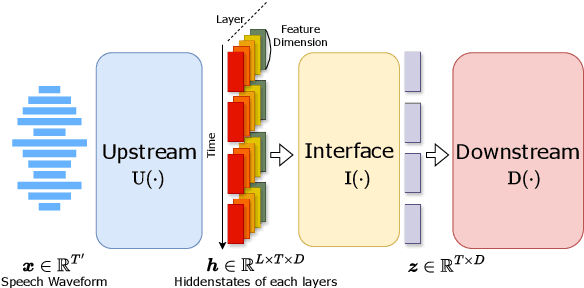
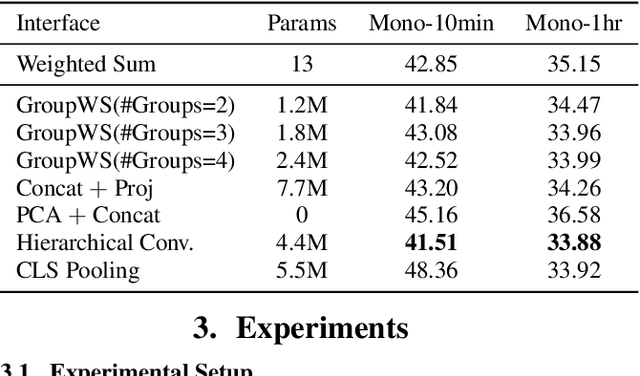

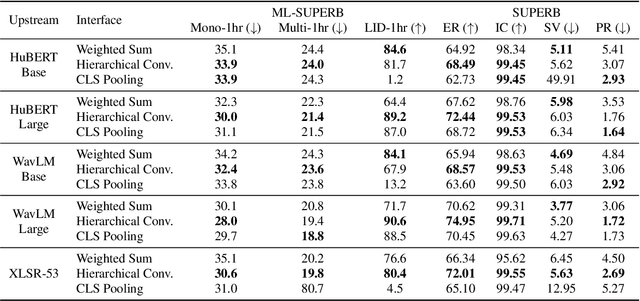
Abstract:Self-supervised speech (SSL) models have recently become widely adopted for many downstream speech processing tasks. The general usage pattern is to employ SSL models as feature extractors, and then train a downstream prediction head to solve a specific task. However, different layers of SSL models have been shown to capture different types of information, and the methods of combining them are not well studied. To this end, we extend the general framework for SSL model utilization by proposing the interface that connects the upstream and downstream. Under this view, the dominant technique of combining features via a layerwise weighted sum can be regarded as a specific interface. We propose several alternative interface designs and demonstrate that the weighted sum interface is suboptimal for many tasks. In particular, we show that a convolutional interface whose depth scales logarithmically with the depth of the upstream model consistently outperforms many other interface designs.
 Add to Chrome
Add to Chrome Add to Firefox
Add to Firefox Add to Edge
Add to Edge